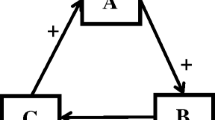Abstract
Individual semiotic systems interpreting their environment are not well understood from the externalist approach typical of the scientific method. Science constructs probabilities describing large populations of systems, not individuals. The Umwelt, as the individually experienced/created aspects of the habitat aspect of its population’s ecological niche, is given an internalist understanding within the framework of the compositional hierarchy. Vagueness is an important aspect of the internalist condition. It is selectively reduced momentarily by creative choices that can have a Peircean semiotic formulation, and which are often unpredictable externally, thereby appearing to be chance events.

Similar content being viewed by others
Notes
Editor’s note: “I use the word phaneron to mean all that is present to the mind in any sense or in any way whatsoever, regardless of whether it be fact or figment.” (Peirce 1931-1958: CP 8.213).
References
Annila, A. (2010). The 2nd Law of Thermodynamics delineates dispersal of energy. International Review of Physics, 4, 29–34.
Ashby, W. R. (1956). An Introduction to Cybernetics. London: Chapman & Hall.
Conrad, M. (1993). The fluctuon model of force, life, and computation: a constructive analysis. Applied Mathematics and Computation, 56, 203–259.
Horowitz, I. A. (1956). The Golden Treasury of Chess. N. Y., Simon & Schuster.
Hutchinson, G. E. (1965). The Ecological Theater and the Evolutionary Play. New Haven: Yale University Press.
Keefe, R. (2000). Theories of Vagueness. Cambridge, UK; Cambridge University Press.
Kleidon, A., Malhi, Y., & Cox, P. M. (2010). Maximum entropy production in environmental and ecological systems. Philosophical Transactions of the Royal Society B, 365, 1297–1302.
Lemke, J. L. (2000). Opening up closure: semiotics across scales. Annals of the New York Academy of Sciences, 901, 100–111.
Matsuno, K. (2000). The internalist stance: a linguistic practice enclosing dynamics. Annals of the New York Academy of Sciences, 901, 332–349.
Matsuno, K., & Salthe, S. N. (2002). The origin and development of time. International Journal of General Systems, 31, 377–393.
Maturana, H. R., & Varela, F. J. (1980). Autopoiesis and Cognition. Dordrecht: Reidel.
Oyama, S., Griffiths, P. E., & Gray, R. D. (2001). Cycles of Contingency: Developmental Systems and Evolution. Cambridge, MA: MIT Press.
Peirce, C. S. (1931–1958). The Collected Papers of Charles Sanders Peirce, vols. 1-8 C. Hartshorne and P. Weiss (Eds.), Cambridge, MA: Harvard Univrsity Press.
Prigogine, I. (1980). From Being To Becoming: Time And Complexity In The Physical Sciences. San Francisco: Freeman.
Salthe, S. N. (1975). Problems of macroevolution (molecular evolution, phenotype definition, and canalization) as seen from a hierarchical viewpoint. American Zoologist, 15, 295–314.
Salthe, S. N. (1985). Evolving Hierarchical Systems: Their Structure and Representation. New York: Columbia University Press.
Salthe, S. N. (1990). Sketch of a logical demonstration that the global information capacity of a macroscopic system must behave entropically when viewed internally. Journal of Ideas, 1, 54–59.
Salthe, S. N. (1993). Development and Evolution: Complexity and Change in Biology. Cambridge, MA: MIT Press.
Salthe, S. N. (1999). A semiotic attempt to corral creativity via generativity. Semiotica, 127, 481–495.
Salthe, S. N. (2001). ‘Theoretical Biology’ as an anticipatory text: the relevance of Uexküll to current issues in evolutionary systems. Semiotica.134, 359–380.
Salthe, S. N. (2008). The System of interpretance, naturalizing meaning as finality. Biosemiotics, 1, 285–294.
Salthe, S. N. (2012). Hierarchical structures. Axiomathes, 22, 355–383.
Salthe, S. N. (2013). To naturally compute (something like) biology. Progress in Biophysics and Molecular Biology, 113, 57–60.
Salthe, S. N. (2014). A mode of ‘epi-thinking’ leads to exploring vagueness and finality. In M. Lissack & A. Graber (Eds.), Modes of Explanation: Affordances for Action and Prediction. New York: Palrave Macmillan.
Salthe, S. N., & Matsuno, K. (1995). Self-organization in hierarchical systems. Journal of Social and Evolutionary Systems, 18, 327–338.
Van Deemter, K. (2010). Not Exactly: In Praise of Vagueness. New York: Oxford University Press.
von Uexküll, J. (1926). Theoretical Biology. London: Harcourt Brace.
Acknowledgements
I thank Victoria Alexander and James Coffman for helpful comments and criticisms.
Author information
Authors and Affiliations
Corresponding author
Rights and permissions
About this article
Cite this article
Salthe, S.N. Creating the Umwelt: From Chance to Choice. Biosemiotics 7, 351–359 (2014). https://doi.org/10.1007/s12304-014-9204-1
Received:
Accepted:
Published:
Issue Date:
DOI: https://doi.org/10.1007/s12304-014-9204-1




